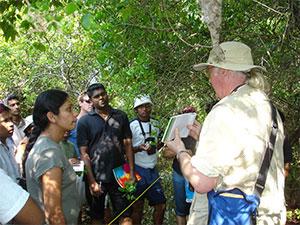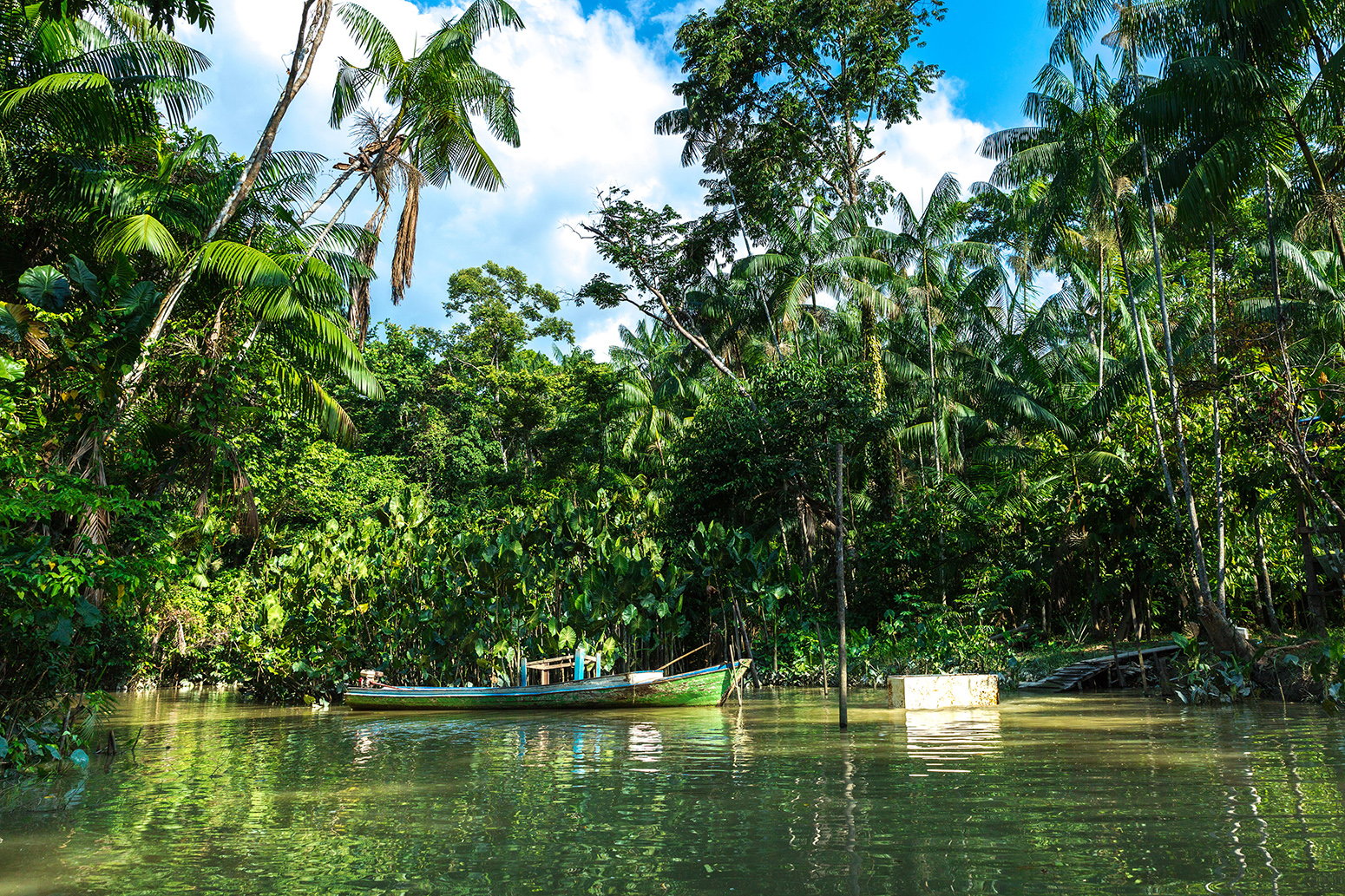MAP selected for unique fundraising project 
THAILAND – MAP works in SE Asia providing practical, proven methods of education and training so coastal communities can conserve and restore their own mangrove forests. MAP has been collaborating with Ban Nai Nang to generate new income from
beekeeping while restoring their mangrove forests. The village is now producing honey from mangrove flowers, and value-added products such as hand soaps, shampoos and balms. 10% of honey product sales goes into a Conservation Fund that gets put back into restoring mangroves that the area has lost in the past. Now, Nai Nang wants to pass that knowledge on to other communities. Just recently, the GlobalGiving Foundation selected us to participate in its Accelerator, a fundraising opportunity for nonprofit organizations around the world. In order to succeed,
we must raise $5,000 from 40 donors by October 2nd. If we meet this threshold, we will be permanently featured on GlobalGiving’s website.
READ MORE AFRICA
Re-establishing a more biodiverse and resilient coastal ecosystem with community participation

WEST AFRICA – West Africa is ranked high on the list of regions threatened by climate change. Severe drought, massive deforestation, unsustainable agricultural practices, and poor watershed management have left much of West Africa dangerously vulnerable to sea-level rise and extreme weather events provoked by climate change. Restoration and conservation of the region’s wetlands, especially their mangrove ecosystems, is a vital part of disaster mitigation and coastal protection strategy proposed for the region. Community-Based Ecological Mangrove Restoration (CBEMR) involves a more methodological ecosystem approach than the usual monoculture restoration efforts, incorporating natural mangrove dispersal and ecological recovery. The key is in the restoration of the hydrology of the area being considered for restoration, and then working with nature itself to help facilitate regeneration of the area’s naturally occurring mangrove species. Adequate monitoring and evaluation follow this at each site to assess progress and take corrective action to ensure success and replicability (Lewis et al., 2006). READ MORE (Page 39-44)
Community key for successful mangrove restoration

KENYA – Traveling between remote islands by dugout canoe, and trudging through muddy mangrove forests in 40-degree Celsius heat coaching fisherfolk on monitoring techniques is all in a day’s work for Madagascan marine conservationist Lalao Aigrette. Aigrette is passionate about finding ways to keep these valuable “blue forests” standing, and she’s been named an International Union for the Conservation of Nature (IUCN) “natural-born hero” for her contributions. She works for marine conservation non-governmental organization (NGO) Blueventures, where she oversees the development of Tahiry Honko, the first Plan Vivo carbon initiative in the country, and the second mangrove carbon project in the world. Aigrette shared her views with Landscape News in the lead-up to the Global Landscapes Forum in Nairobi later this month, to find out more about her ground-breaking community-based restoration work, and her hopes for the forum. READ MORE
ASIA
Restoring the green cover: 133 hectares more under mangroves

INDIA – The mangrove cell of Maharashtra’s forest department, in a study, has said that there has been a 133 hectare rise in mangroves in Mumbai Metropolitan Region. The state Mangrove Cell experts claim that it was possible due to a sense of environment conservation among people and strict action against encroachments and encroachers. There has been an increase in the number of staff hired in the state cell, including forest guards, and around 108 security personnel from the Maharashtra State Security. “Public awareness is another major reason. People have realised the importance and need of green lungs where we live. Increased awareness among citizens through regular exchange of information through different mediums helped,” he said.READ MORE
Stand-off ups tension between shrimp farmers and environmental authorities in China

CHINA – A stand-off between shrimp farmers and authorities in eastern China has highlighted the pressure on China’s aquaculture sector from the enforcement of stricter environmental laws. Tighter enforcement of environmental regulations has seen wholesale closures of aquaculture facilities in sensitive shoreline, wetland and reservoir areas around China this year, with a resultant inflationary impact on prices. After authorities moved to close shrimp farms in Nantong, Jiangsu Province, the operators of the ponds took to the streets in dissatisfaction at what they believe is inadequate compensation for the razing. A note from local authorities offering compensation of CNY 5.00 (USD 0.73, EUR 0.64) per square meter also notified shrimp farmers that the electricity to their facilities would be cut off later this month. But the shrimp farmers claim that government encouraged investment in shrimp facilities in 2014 and are seeking higher compensation, as well as guarantees on new land. READ MORE
Crab farming takes over shrimp in Bagerhat

BANGLADESH – Crab cultivation is replacing shrimp cultivation in the district because shrimp and prawn are frequently attacked by virus. “Regular attacks by viruses has caused us losses and we got discouraged to cultivate shrimp. Some shrimp cultivators had to leave their area for not being able to pay off their debts. Moreover, the demand for shrimp has decreased in the overseas market. So the farmers are cultivating crab to overcome the losses incurred in shrimp cultivation and to earn profit,” said Moazzem Hossain, a farmer of Shreefaltala village under Rampal upazila. “In the last few years, the price of shrimp has decreased by almost 50 percent. As a result, the farmers had to give up shrimp cultivation and start cultivating crabs,” he added. “I am cultivating crabs in 10 ponds on three acres of land, using the box and girdle method,” said Arindom Mondol of Sadar upazila. “We buy crab weighing around 100 grams each from nearby warehouse for Tk 200 to Tk 250 per kg. They bring the crabs from the Sundarbans,” he added. READ MORE
AMERICAS
WORLD SCIENTISTS WARNING TO HUMANITY:

USA – All scientists, citizens, companies and organizations are invited to sign/endorse the articles’ recommendations, and help change civilization’s current trajectory. Twenty-five years ago, the Union of Concerned Scientists in Washington, D.C. along with over 1,700 scientists from around the world, including the majority of then-living Nobel laureates in the sciences, drafted and signed the first World Scientists’ Warning to Humanity. That warning is still available at the UCS website, but is also presented herefor you to read and share. On its 25th anniversary, a group of scientists looked back at that first warning to evaluate humanity’s response. What they found was most distressing. With the exception of curtailing depletion of the ozone layer protecting life from the sun’s damaging UV radiation, humanity had failed to make progress in solving the challenges originally documented. Instead things had gotten far worse. READ MORE
Apple to invest in mangrove forest protection and restoration in Colombia

Apple’s Lisa Jackson today announced that it is investing in a project to restore and protect mangroves across a 27,000-acre forest in Colombia. Fast Company reports that Jackson, who serves as Apple’s VP of environment, policy, and social initiatives, made the announcement at the Global Climate Action Summit today in San Francisco. The project will see Apple work to protect and restore mangroves in a 27,000-acre forest along the coastline of Colombia. Jackson says that mangroves can store up to ten times more carbon than a terrestrial forrest: “These forests are critical because they’re one of nature’s most important tools in the battle against climate change–they can absorb and store up to ten times more carbon than a terrestrial forest,” Lisa Jackson, Apple’s vice president of environment, policy, and social initiatives told an audience at the Global Climate Action Summit in San Francisco today.READ MORE
How mangroves help keep the planet cool

USA – Coastal scientists have developed a new global framework to more accurately assess how mangroves along different types of coastlines from deltas to lagoons store carbon in their soil. They found that previous studies have underestimated the blue carbon levels in mangroves by up to 50 percent in some regions and overestimated levels by up to 86 percent in others. Their study published recently in Nature Climate Change will help countries develop and evaluate their carbon footprint and blue carbon inventory that potentially can be used in the global marketplace. “We took a huge step further by testing a robust model that more clearly defines the global variation of carbon storage of coastlines taking into account different tides, river flow, geology and rainfall that occurs around the world,” said co-author Robert Twilley, who is Louisiana State University (LSU) Department of Oceanography & Coastal Sciences professor in the LSU College of the Coast & Environment and the executive director of the Louisiana Sea Grant College Program.
Carbon is one of the most abundant chemical elements on Earth. It is in the atmosphere, the ocean and the human body. READ MORE
Editor’s note – Although this article claims Hawaii is the only known place where removal of mangroves has been persued, MAP reported on a similar New Zealand’s Coromandel Peninsula eradication process in 2010 – see Prof Gordon Maxwell’s comments here
Why Hawaii Is Burning Its Massive Mangrove Trees

USA – All over the world, from Florida to Thailand, efforts are underway to restore mangrove forests. These ecosystem have been in serious decline for the last 10 years, and sea level rise is set to threaten them further. In Hawaii, however, heavy efforts are underway to eradicate the trees. In fact, the islands might be the only place where ecologists are trying to permanently remove mangroves. They’re invasive here—and they’re pushing out native flora and fauna that have called these islands home for much longer than the mangrove has. In He‘eia, groups have been working since the ’70s to restore native wetlands. But removing invasive mangroves has really ramped up since last year as part of a greater effort to restore the region’s estuary system. None of the researchers or community leaders I spoke with were familiar with any other effort anywhere in the world to get rid of mangroves (See editor’s note above). READ MORE
Amazon mangroves ‘twice as carbon rich’ as its rainforests

BRAZIL – The vast mangroves of the Amazon store twice as much carbon per hectare as the region’s tropical forests, new research shows. The relatively understudied ecosystem also stores 10 times more carbon than Amazon savannahs – a type of grassy plain with sparsely populated trees, according to the study. However, the wetlands face threats from deforestation and climate change, the researchers say. Introducing more measures to protect mangroves will be key to preserving its large carbon store, they add. The findings provide “yet more evidence of the extraordinary carbon stocks found in mangroves” worldwide, another scientist tells Carbon Brief. The Amazon is well known for its 167m hectares of rainforest, but is less known for being home to close to 1m hectares of “mangrove” forests. READ MORE
OCEANA
Planting Mangroves To Protect Fishing Grounds

FIJI – For families in the country mangroves are our lifeline, says Torika Lewaca. The 59-year-old Tavualevu villager is one of the many women in Tavua who enjoys fishing. They depend on mangroves within their traditional fishing grounds for their livelihoods and protection from the impacts of salt water intrusion. Ms Lewaca and fellow community members were part of a mangrove planting activity carried out along a section of Tavua Bay that forms the Tavualevu Village ‘coastline boundary. About 400 mangrove propagules were directly planted within the village’s demarked coastline during last week’s Constitution Day. For Tavualevu Village, being one of the largest villages in Fiji, sustaining the community’s livelihood and food consumption is quite a challenge for families. “Mangroves are not only home for crabs, but places for them to feed and grow. So we need to have a lot of mangroves in place to have a lot of crabs and fish,” Ms Lewaca said. “I am here planting because I want our future crab catchers to not only also have the opportunity to hunt for crabs, but to have enough as well to be able to feed our families and financially support them.” READ MOR
LAST WORD
Dear Alfredo,
Thank-you for adding the endorsement of your organization to the World Scientists’ Warning to Humanity. We will be direct and emphatic here. It is absolutely urgent that we do so. We need you to share this project via the website link as widely as possible. We’re not asking for donations and we never will. We’re asking you to help us develop a ‘constituency’ of concerned individuals and organizations so that we can change humanity’s complacency about what amounts to a matter of survival, not just for us, but for many other species and ultimately for life on Earth.
Sounds serious? The seriousness of the situation cannot be overstated.
So please share the website widely, within your organization, to other organizations with which you interact, and personally to family, friends, and colleagues. Since we each tend to circulate in our own little bubbles of people with similar world views, also try to share outside of your usual sphere. Challenge yourself!
And if you are moved to do more, please reply to this email and we will be back in touch with you. To change the direction and momentum of civilization it will take many of us doing the most we can do within the limits of our own personal situations.
Sincere thanks,
Stuart Scott, Director
stuart@scientistswarning.org





























